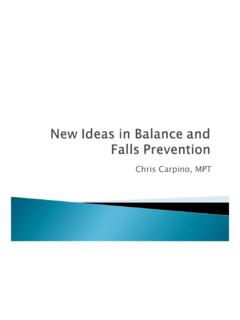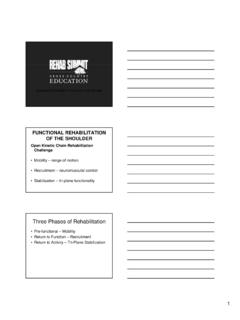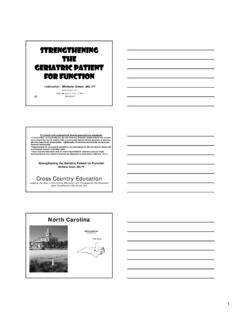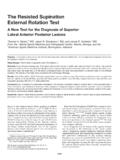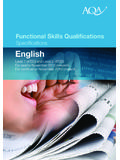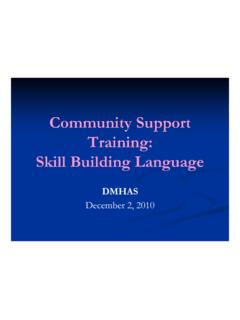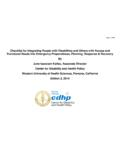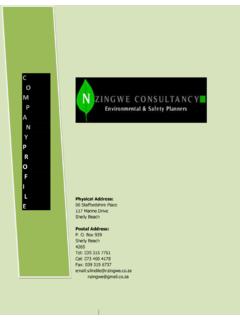Transcription of ADL Assessment “Back to Basics” - content.ccrn.com
1 07/17/08Dr. Jose Rafols_Clinical Instructor1 ADL Assessment back to basics Use of Activities of Daily Living as an evaluation, as a treatmeUse of Activities of Daily Living as an evaluation, as a treatment nt modality, or bothmodality, or both LetLet s get to back to Basicss get to back to Basics07/17/08Dr. Jose Rafols_Clinical Instructor2To comply with professional boards/associations standards, I declare that I do not have any financial relationship in any amount, occurring in the last 12 months with a commercial interest whose products or services are discussed in my of Activities of Daily Living: As an evaluation, As a treatment modality or bothJose R. Rafols, OTD, MHSA, OTR/L, CEAS Clinical InstructorCross Country Education Leading the Way in Professional Development. Jose Rafols_Clinical Instructor3 Assessment of Performance ADL sLearning Objectives1. Weave ADL interventions into your daily therapeutic milieu or rehab Become familiar with the various performance areas of ADL s, BADL s, IADL s, Occupational Based Activities, Play and Leisure Become familiar with interventional strategies that assist the patient in regaining lost function in the clinic, home or at Fully understand why ADL s are such an important component of the patent's daily Jose Rafols_Clinical Instructor4 Assessment of Performance ADL sDefinition of ADL [?]
2 ] Activities of Daily LivingActivities of Daily occupation based tasks that include personal care, functional mobility, communication, home management, and work & community reintegration. ADLADL that require advanced planning and more complex skill-sets are called IADL (instrumental activities of daily living).07/17/08Dr. Jose Rafols_Clinical Instructor5 Use of Activities of Daily Living as an evaluation, as a Use of Activities of Daily Living as an evaluation, as a treatment modality, or bothtreatment modality, or both s?s?ADL s is ..that carries us over, under & around obstacles we encounter everyday throughout our internal & external s and its ..is what makes up the very fabric of our everyday s are the most basic component of rehab and is what helps the pts are the most basic component of rehab and is what helps the pt. establish homeostasis. establish homeostasisthroughout their functional livesthroughout their functional Jose Rafols_Clinical Instructor6A Comprehensive ReviewA Comprehensive Review ADLADL ssOccupational Performance Model (OPM)Occupational Performance Model (OPM)07/17/08Dr.
3 Jose Rafols_Clinical Instructor7A Comprehensive ReviewA Comprehensive Review ADLADL ss (Occupational Performance Model)(Occupational Performance Model)Occupational Performance Model: Occupational Performancedescribes the content of the OT process ..its the domain of concernwithin OT practice ..across all specialty areas (Ped s, Adults, Geriatrics). Work, play and self-carehave always been at the core of OT assessments & treatments. ADL is a important is known as the performance area within the occupational performance model .07/17/08Dr. Jose Rafols_Clinical Instructor8A Comprehensive ReviewA Comprehensive Review ADLADL ss (Occupational Performance Model)(Occupational Performance Model)Performance areas & components:The three (3) areas germane to the Occupational Performance Model are: Activities of daily living Work & productive activities Play & Leisure activities07/17/08Dr. Jose Rafols_Clinical Instructor9A Comprehensive ReviewA Comprehensive Review ADLADL ss (Occupational Performance Model)(Occupational Performance Model)Activities of Daily Living are considered to be the self- maintenance tasks/skills everyone does: Feeding, bathing, dressing, hygiene are tasks are performed every day.
4 These maintenance tasks are whatmaintain one s health and prevent physicaland mental degradation. These tasks vary according to each patient; however, the act of performing themis what makes thema standardized process. 07/17/08Dr. Jose Rafols_Clinical Instructor10A Comprehensive ReviewA Comprehensive Review ADLADL ss (Occupational Performance Model)(Occupational Performance Model)Work and Productive Activities [Occupational Based Activities]: Most societies engage in work or work-like chores; some of these chores are based on subsistence chores, some are voluntaryin nature and some perform traditional work tasksfor financial motives.(a) Subsistence ( securing shelter, collecting firewood, herding-grazing cattle or retrieving water ).(b) Voluntary ( candy striping; volunteer fire-fighter or community watch groups-or-services).(c) Traditional ( any occupation that is performed for financial reasons or for reimbursement of their services). 07/17/08Dr. Jose Rafols_Clinical Instructor11A Comprehensive ReviewA Comprehensive Review ADLADL ss (Occupational Performance Model)(Occupational Performance Model)Play and Leisure Activities Most, if not, all societies engage in leisure activities are performed individually or in organized groups.
5 Play and leisure activities are fundamental in helping children develop skills needed in future growth. Play and leisure activity are precursors for developing the skills needed for organized work or occupational tasks. 07/17/08Dr. Jose Rafols_Clinical Instructor12A Comprehensive ReviewA Comprehensive Review ADLADL ss The (7) areas of Occupational Performanceare the ADL categories that have been discussed in detail earlier (*where the rubber meets the road):1. Bathing-showering2. Bowel-bladder management & toileting3. Dressing4. Eating5. Feeding6. Functional mobility7. Personal hygiene 07/17/08Dr. Jose Rafols_Clinical Instructor13A Comprehensive ReviewA Comprehensive Review ADLADL ssPerformance areas of ADL sKnow your ADL s07/17/08Dr. Jose Rafols_Clinical Instructor14 Performance areas of ADL s Know your ADL sThe various components of ADL s When selecting ADL activities, choose simple tasks, then work towards more complex ones. Don t forget to assess ADL s and IADL s;both are important.
6 ADL assessmentsshould not be completed in one this approach may fatigue the patient. Try notto create artificial situationswith regards to the ADL assessments (*do not (*do not spend valuable time on an ADL component that will spend valuable time on an ADL component that will never be performed by the patient independently).never be performed by the patient independently).07/17/08Dr. Jose Rafols_Clinical Instructor15 Performance areas of ADL s Know your ADL sThe various components of ADL s ADL assessmentshelp identify how the patient compensatesor tries to modify a given ADL or self-care task. ADL assessments and treatmentsassist you in identifying thecommoncauses of patient compensation: muscular weakness & decreased endurance or work tolerance spasticity , rigidity & involuntary movements Tremors Posturing Perceptual & cognitive deficits07/17/08Dr. Jose Rafols_Clinical Instructor16 Performance areas of ADL s Know your ADL sThe various components of ADL s Privacy:Respect the patient s need for privacy; meaning, the patient s feelings toward having his/her body disrobed and/or viewed by others.
7 Be prepared:ADL dressing may be impacted by the patient s need for privacy. De-ja-vu:You may also have to deal with similar issues when engaged in manual therapy, mat activities, as well as, ADL can bePrivacy can beoverlooked in manyoverlooked in manyways; culture, genderways; culture, genderage, stature, and soage, stature, and Jose Rafols_Clinical Instructor17 Performance areas of ADL s Know your ADL sThe various components of ADL s Ask what ADL taskthe patient wishes to work on first (*known as, client centered approach). Ask what the patient s feelingsare towards relearning or regaining lostADL tasks or abilities. Ask the patient what their feelings are towards independenceor towards being dependent on and other family Jose Rafols_Clinical Instructor18 Performance areas of ADL s Know your ADL sThe various components of ADL s As well as evaluating ADL, BADL s & IADL s, make sure you evaluate the patient s occupational [work]environment. (*Work/Volunteering = is considered an occupation)(*Work/Volunteering = is considered an occupation) The evaluator should begin the evaluation by explaining why the ADL evaluation is being performed.
8 The evaluator should invite the caretaker, family member or spouse to participate in the evaluation (*good (*good intelintel can be gleamed from can be gleamed from the spouse or family member). the spouse or family member). 07/17/08Dr. Jose Rafols_Clinical Instructor19 Performance areas of ADL s Know your ADL sThe various components of ADL s Simulatethe patient s home set upin the gym or ADL-training-suite, as this will allow the patient to adapt to the home environment once he/she is discharged. However, the evaluator should perform a home Assessment (*when possible) to identify any barriers or safety Jose Rafols_Clinical Instructor20 Performance areas of ADL s Know your ADL sADLADL--Advisory:Advisory:ADL evaluations performed in the clinic s ADL-Suite cannot accurately predict all the environmental barriers found at the patient s , you should not assume that functional independence in the clinic will automatically carry over to the patient s Jose Rafols_Clinical Instructor21 Interventional Strategies ADL sActivities of Daily Living can be formally evaluated, can be used as a treatment or both:07/17/08Dr.
9 Jose Rafols_Clinical Instructor22 Interventional Strategies ADL sActivities of Daily LivingActivities of Daily Living using formal commercial formal commercial assessmentsassessmentsor can be performed or can be performed through through informal meansinformal (verbal (verbal intake & clinical observations).intake & clinical observations). Treatment ModalityTreatment a therapeutic as a therapeutic intervention only. combination of a combination of evaluation & treatment can be weaved evaluation & treatment can be weaved can occur can occur Jose Rafols_Clinical Instructor23 Interventional Strategies ADL sActivities of Daily LivingActivities of Daily Living Standardized or Commercial Assessments:Standardized or Commercial Assessments:a. a. FIMFIM ss ..(functional independence measure) measures the (functional independence measure) measures the degree of patient disability w/in the adult rehab of patient disability w/in the adult rehab b. BrainBrain--Book AssessmentBook Assessment for TBI patients; assesses for TBI patients; assesses residual function s/p function s/p c.
10 FallFall--Risk Assessment Risk Assessment .. assesses patientassesses patient s at risk for falls s at risk for falls at d. KleinKlein--Bell ScaleBell Scale .. assesses the patientassesses the patient s ADLs ADL s & takes s & takes into account use of adaptive account use of adaptive e. AMPSAMPS .. ( Assessment of Motor Process Skills); assesses ( Assessment of Motor Process Skills); assesses the patientthe patient s IADLs IADL s. s. 07/17/08Dr. Jose Rafols_Clinical Instructor24 Interventional Strategies ADL sActivities of Daily LivingActivities of Daily Living Standardized or Commercial Assessments:Standardized or Commercial Assessments:f. f. SOTOFSOTOF .. structural observational test of structural observational test of functionfunction; assesses IADL; assesses IADL s and the underlying s and the underlying skills required to do these required to do these g. SAFERSAFER .. safe Assessment of function & the safe Assessment of function & the environment for rehabilitationenvironment for rehabilitation; assesses the ; assesses the patientpatient s level of safety at level of safety at h.

